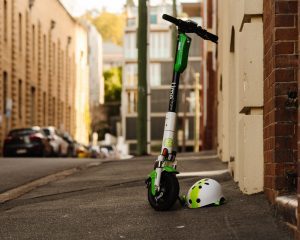We all know how essential it is to wear a dual sport helmet when we’re out riding around town. It’s not just about obeying the law; it’s about protecting our heads and potentially saving our lives. But how often do we think about the maintenance of our helmet? Just like any other piece of safety equipment, they need regular care to function at their best.
Scooter helmets are often neglected, with riders forgetting that, much like motorcycle helmets, they require regular cleaning and maintenance. Ensuring the visor is clean and free from water spots is crucial for clear visibility, and allowing the helmet to dry thoroughly after cleaning is essential to maintain its effectiveness and hygiene.

At FamilyHype, we’re passionate about helping you keep your helmet pristine. From inspecting for damage, cleaning, and understanding proper storage methods, to recognizing when it’s time for a replacement, we’ve got you covered. A significant part of this is the cleaning process. Use a damp cloth with mild soap to keep both the exterior and helmet’s interior clean. It’s not only about keeping your helmet clean but also making sure it’s stored in a cool, dry place, away from prolonged sunlight, which can degrade its materials.
Remember, it’s important to inspect your helmet periodically. Check for cracks, dents, or loose straps and be proactive about replacements. Understanding the importance of certified helmets can’t be stressed enough. They adhere to rigorous safety standards ensuring optimum protection during accidents. And, if they show signs of wear or they’re over 5 years old, consider getting a new one.
By prioritizing your helmet’s care, you’re investing in safety for both yourself and your loved ones. This guide offers all you need to uphold the highest standards in helmet upkeep.
Key Takeaways
We’ve seen how crucial it is to properly maintain our helmets. It’s not just about cleaning and storing them correctly, but also regularly inspecting for damage and replacing parts when needed. We value the family unit and want to make sure that everyone is safe and protected. We encourage you to always use a certified helmet and to pay attention to any signs of wear and tear, knowing when it’s time to replace it to avoid any potential danger.

When discussing scooters, the primary focus is safety. Safety encompasses factors like speed, protection, durability, and visibility. Terms like mobility, balance, and control are also closely related to the subject. Wearing a certified helmet and understanding when to replace it ensures our safety. For our well-being and that of our families, let’s prioritize the upkeep of our helmets!
Regular Inspection To Check For Damage
Don’t overlook the importance of regularly inspecting for damage, as even the tiniest crack or dent can compromise its safety performance. At FamilyHype, we believe it’s our responsibility to ensure all safety features are working optimally and preserving its lifespan.
By doing this, we not only protect ourselves but also set an example for others to follow.
Now that we’ve identified potential damage, let’s turn our focus on keeping it clean. Whether it’s a full-face helmet, an open-face helmet, or an aero-style helmet, they come in many different shapes, sizes, and designs, and we’ll be exploring each of them. Each has its own unique attributes and values, including safety features and design elements.
Additionally, it’s important to consider the materials used, such as fiberglass and carbon fiber.
Cleaning Your Helmet
Before hitting the road, you’ll want to give that grubby lid a good scrub to clear off any stubborn dirt and bugs. Here’s how to clean your helmet, a key part of staying safe on the roads.
- Use mild soap and water for cleaning.
- Focus on sweat absorption areas like padding.
- Odor prevention sprays can keep it fresh.
Taking care of yourself and others on the road starts with properly caring for our own gear. Proper care, such as regular cleaning, can ensure your helmet is durable and in good condition for longevity. Additionally, store your helmet in a cool, dry place and use an appropriate bag for extra protection when not in use.
Proper Storage Of Your Helmet
Treating your helmet with respect by storing it properly is essential to keeping your safety on the road in a cool, dry place away from direct sunlight. To prevent theft, adding a lock to your helmet is a great idea. Safety should always be your top priority.
In addition to proper storage, it’s important to know when and how to replace its parts. This includes replacing the outer shell, inner lining, and straps, as well as replacing any bolts, snaps, and visors. With proper care and upkeep, it can last you for many years and keep you safe each ride.
Replacing Helmet Parts
Let’s move on to another equally crucial aspect: parts replacement. We’ll delve into specifics such as changing the visor, which is critical for clear visibility while riding, and replacing the interior padding, essential for comfort and safety.
These are vital steps in ensuring our helmets remain effective in protecting us during our adventures.
Changing Visors
Swapping out a scratched or cloudy visor on your helmet isn’t just about keeping it looking sharp; it’s like giving yourself a new pair of eyes, enhancing your view of the open road.
The importance of safety and comfort when riding is paramount, so changing your visor can make all the difference. You’ll feel safer with improved visibility, and you can choose from different tint options to offer you relief from bright sunlight. Additionally, anti-fog solutions can eliminate those nervous moments in damp weather. Altogether, replacing the visor and interior padding can provide you with the best experience. From improved visibility to improved comfort and hygiene, make sure to check out the different visor and padding options available and enjoy the ride with enhanced safety and comfort!
Replacing Interior Paddings
When it’s time to freshen up the interior padding of that protective headgear, you’re not just adding comfort but also enhancing safety and hygiene. We understand the importance of safety; that’s why we can evaluate the comfort level and choose suitable padding materials to ensure a snug fit for riders.
Now let’s move on, as recognizing when your helmet has served its course is equally critical for safety. Before replacing the interior padding, you should check the age, type of padding, and padding material to make sure you’re getting the right fit. Also, make sure to regularly inspect for cracks, tears, and other damage.
When To Replace Your Helmet
When it comes to safety, we can’t overlook the fact that helmets need to be replaced every five years, on average. This is our responsibility as riders, and with so many upgrade options available, it’s important to choose wisely. Certified helmets play a crucial role in ensuring our safety, and that’s why you should invest in quality helmets that have been tested and approved by the relevant authorities.

We should also be aware of the various components, such as comfort, design, fit, ventilation, and weight. By ensuring that these components are up to date, we can ensure a safe and enjoyable ride. Additionally, we should also consider the brand, as some brands offer better protection than others.
Finally, we should always strive to keep our scooters in good condition. Regular upkeep and inspections can aid in identifying any potential issues, so we can stay safe on the road. Take the time to inspect your helmets and scooters regularly, and always consider replacements when it’s time.
Importance Of Using Certified Helmets
Don’t underestimate the value of using certified helmets, folks! They aren’t just about style or comfort; they’re vital for your well-being. Remember:
- Certification standards guarantee that a helmet meets specific safety benchmarks.
- A proper helmet fit ensures the protection works as intended.
- Using uncertified helmets can jeopardize your well-being.
We encourage everyone to prioritize safety by using certified helmets, which are important for more than just the protection of the rider but also to protect others in the area.
To ensure you are using a certified helmet, look for the following:
- A label or marking from the US Department of Transportation (DOT)
- A manufacturer’s label with the model and size
- A label indicating it meets the Consumer Product Safety Commission standards
Let’s prioritize serving others by promoting and using safe, certified helmets.
Conclusion
We’ve seen how crucial it is to properly care for our helmets. It’s not just about cleaning and storing them correctly, but also regularly inspecting for damage and replacing parts when needed. We encourage you to always use a certified helmet and to pay attention to any signs of wear and tear, knowing when it’s time to replace it to avoid any potential danger.
Having a well-maintained motorcycle helmet is paramount for safety on the road. Regularly cleaning it with warm water and a microfiber cloth not only ensures visibility through the visor but also prolongs the lifespan of the helmet, making it an essential practice for all motorcycle riders to ensure the reliability of their gear, especially when investing in the best motorcycle helmets for optimal protection.
Let’s commit to protecting ourselves by taking good care of our helmets just like when you clean a motorcycle! Ultimately, using a certified helmet and knowing when to replace it can be lifesaving.
Frequently Asked Questions (FAQs)
How Often Should You Change Your Helmet?
Helmets protect users from severe hits, but they wear out over time. Replace them every three to five years. Even if they don’t appear damaged, UV radiation can destroy materials. Such degradation, even if invisible, can significantly reduce the helmet’s protective capabilities, putting the wearer at risk.
How Often Should You Clean Your Helmet?
Cleaning a helmet, in the same way as you clean your motorcycle helmet, ensures its longevity and keeps hygiene. The exterior, often exposed to dust and bugs, should be cleaned after each ride. On the other hand, the interior, absorbing sweat and skin oils, benefits from a monthly cleaning or even more frequently during heavy use. Using a mild detergent and water can keep the helmet smelling fresh and free from bacteria.
How Do You Maintain A Helmet?
For the outer part, tackle dead bugs and grime from the shell using a wet microfiber cloth. This cloth, gentle yet effective, aids in preserving the finish. For the visor or face shield, a concoction of baby shampoo and water is ideal, ensuring no residues. Use a glass cleaner or window cleaner for an extra shine. For a deeper clean, especially for the interior and liner, remove and immerse them in a mesh garment bag. Hand wash using a mild laundry detergent or baby shampoo. Opting for a hand wash rather than a machine keeps the integrity of the liner. However, if you must use a machine, ensure it’s on a delicate cycle. If you have access to a shower head, it can aid rinse off the soap thoroughly. After washing, use a wet cloth to gently pat off excess water without wringing the material. Let the helmet air-dry, or use a hair dryer on a low setting. Always pat dry with a microfiber cloth to ensure no scratches. Store it in a cool, dry place, occasionally placing dryer sheets inside for freshness. Regular care routines like these ensure clarity, hygiene, and overall safety during your adventures. Always choose quality products to deliver the best results.
Do Helmets Expire If Not Used?
Yes, even unused helmets have a shelf life. The materials, particularly the protective foam inside, undergo natural degradation processes. These processes can be hastened by environmental factors like temperature fluctuations and humidity, even if it is unused. Therefore, it’s prudent to replace helmets every 3-5 years, irrespective of how frequently they’ve been worn.
How Long Are Helmets Good For?
They are manufactured to provide maximum protection for about 3-5 years from their production date. Over time, even absent any visible damage or significant wear, the materials start to deteriorate. Factors like UV exposure, moisture, and the natural aging of materials compromise its protective attributes. Always consult the manufacturer’s recommendations, but using a helmet beyond this timeframe can reduce its effectiveness.
How Do I Know If My Helmet Is Damaged?
There might not always be obvious signs. However, visible indicators can include cracks, dents, or deformities in the outer shell or inner foam. Additionally, if the retention system becomes loose or any of its components feel compromised, it’s a sign of wear. After any significant impact, even if there’s no visible damage, the protective capacity can be diminished, warranting a replacement.
What Is The Best Way To Sanitize Helmets?
A mix of mild detergent and warm water is effective for cleaning both the exterior and interior. For the internals, removable pads can be washed separately, while non-removable parts should be wiped gently. Thoroughly rinsing and allowing the helmet to air dry, away from direct sunlight, ensures no residue remains. Avoid using harsh chemicals, as they can degrade materials.
How Long Does A Helmet Take To Dry?
The drying time varies based on conditions like humidity and ventilation. After washing, it typically takes several hours to dry thoroughly in a well-ventilated area. Placing it in an airy spot speeds up the drying process. It’s crucial to ensure it is completely dry before using it again, as moisture can compromise its protective features and lead to bacterial growth.
How Important Is A Good Helmet?
It is paramount for safety. It absorbs shock and protects the skull from impact. Wearing a good helmet when riding or doing other head injury-prone activities aids prevent serious injuries. Investing in a good helmet is investing in personal safety.
How Do I Protect My Helmet From Sweating?
Sweating is natural, but excessive moisture can degrade the materials and reduce their lifespan. Using moisture-wicking skull caps or liners can absorb sweat and prevent it from soaking into the padding. Ensure the helmet is aired out after each use, and clean it regularly to remove salts and oils from sweat. Additionally, choosing a helmet with the best ventilation can reduce sweating effectively by keeping the head cooler during activities.
DISCLAIMER (IMPORTANT): This information (including all text, images, audio, or other formats on FamilyHype.com) is not intended to be a substitute for informed professional advice, diagnosis, endorsement or treatment. You should not take any action or avoid taking action without consulting a qualified professional. Always seek the advice of your physician or other qualified health provider with any questions about medical conditions. Do not disregard professional medical advice or delay seeking advice or treatment because of something you have read here a FamilyHype.com.